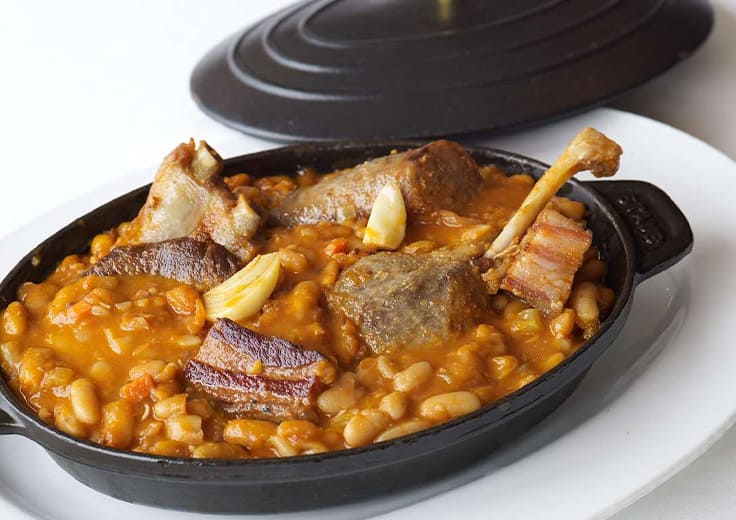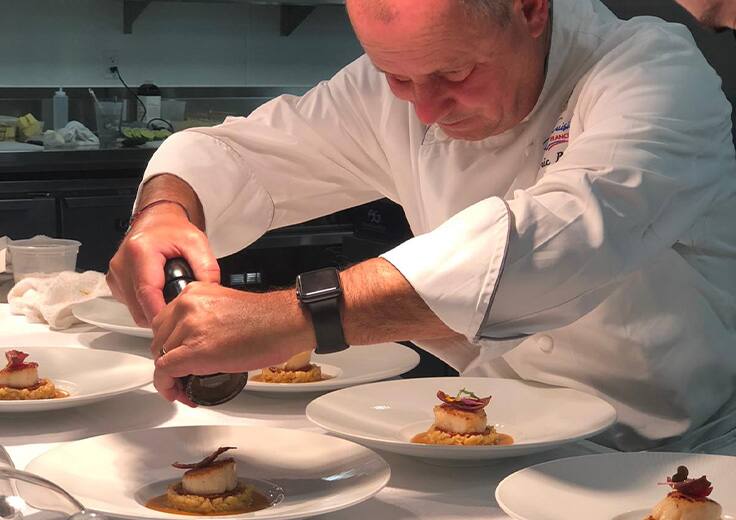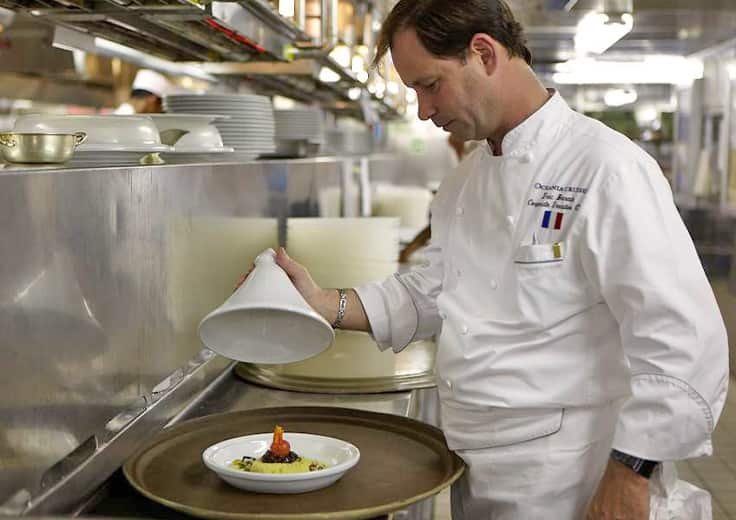Eric’s Homemade Duck Cassoulet Recipe
Growing up between Toulouse and Castelnaudary – France’s famed “capital of cassoulet” – duck cassoulet is the great family-style farm dish of my region in southern France. My grandmother, Germaine, taught me how to make this traditional French dish during my childhood. She was such a natural cook – what we call a cordon bleu, someone who can make really good simple food from the ingredients on hand. Cassoulet is that kind of dish, made with whatever meat a family can raise or buy. Sometimes ours had a pig’s ear, and if it did, my father and I would always fight over who got that special treat.
This is a soulful, richly layered recipe that we serve on board Oceania Cruises as well. It’s made with fresh pork sausages from the Toulouse region as well as pork ribs and two kinds of duck—fresh breasts and confit legs. I like to use pork skin to cover the pot (see the recipe note) to add flavor and a little crunch to the finished dish, a reminder of those pigs’ ears I loved as a child. I hope this recipe brings as much joy into your home as it does mine.

Eric’s Homemade Duck Cassoulet Recipe
Serves 6
INGREDIENTS
1 1/2 pounds white beans, preferably coco or tarbais from France
2 to 3 tablespoons duck fat or canola oil
One 1-pound piece flat pancetta
One 6-bone rack baby back pork ribs
1 whole duck breast, about 1 pound, cut into 1-inch cubes
1/2 cup coarsely chopped carrot
1/2 cup coarsely chopped celery
1 1/2 cups coarsely chopped onion
1 cup coarsely chopped tomato
½ tablespoon finely chopped garlic
1 tablespoon tomato paste, optional
¾-pound mild pork sausage, in one large piece, preferably French, from Toulouse, or sweet Italian sausage
1 bouquet garni
6 to 8 cups chicken stock, warm, plus additional as needed
1 parchment paper lid or a piece of pork skin slightly larger than the pot the cassoulet will be cooked in (see Chef’s Notes below)
3 confit duck legs
6 large garlic cloves, optional
About 1 ½ cups roughly torn bread, optional
Extra virgin olive oil, optional
DIRECTIONS
Place the beans in a large bowl, cover by 2 inches with cold water, and let soak overnight. Drain the beans and set aside.
Choose a pan that will hold all of the ingredients without overcrowding them. A large stock pot with high sides is preferable. A cast-iron cocotte or Dutch oven can be used, but the preference is a high-sided stock pot because there will be less evaporation than in a pot with lower sides.
Heat a generous film of duck fat over medium heat until warm. Caramelizing some of the meat slightly will add richness to the dish and give it a bit of sweetness.
Place the pancetta in the fat and cook until a light golden brown, 3 to 4 minutes per side. Remove from the pot and brown the rack of pork meat, side down, until a medium golden brown, 6 to 8 minutes. Remove from the pot and add the pieces of duck, skin side down, and cook until a medium golden brown, 1 to 2 minutes. Remove from the pot.
Leaving a generous film of fat in the bottom of the pot, pour off any excess. Stir in the carrot, celery, onion and tomato. Stir to coat in the fat and cook just to begin to exude some of the liquid from the tomatoes, 2 to 3 minutes.
Stir in the garlic followed by the tomato paste if using. The tomato paste will give the cassoulet a richer color and a thicker texture. If you prefer a looser cassoulet, it can be left out. Continue stirring occasionally and cook until the vegetables are tender, but still firm, 3 to 4 minutes.
Poke the sausage a few times with a fork and add to the pot, along with the pancetta, rack of pork ribs and duck breast. Top with the beans and the bouquet garni. Pour in the chicken stock. All of the ingredients should be covered. Stir to ensure the ingredients are equally distributed.
Bring the stock to a simmer and cover with a parchment lid or drape the pork skin, if using, over the top of all the ingredients. Since the pork skin will be slightly larger than the pot, it can slope up the sides and it will shrink as the dish is cooked.
Cook, adding more stock as needed to keep the ingredients covered, until the beans are completely tender, about 1 ½ hours. Once tender, nestle the duck confit in the mixture and continue cooking for 20 to 30 minutes, or until the legs are tender.
The cassoulet can be served at this point or covered and refrigerated overnight. By refrigerating the cassoulet overnight, the fat will solidify, and is easily removed.

TO SERVE
If the cassoulet has been refrigerated overnight, preheat the oven to 350˚F. Remove the fat from the top and discard. Place in the oven until warmed through, about 30 minutes, and then continue following the steps below.
If serving directly after cooking, blanch the garlic. Bring a medium pot of salted water to a boil. Add the garlic cloves and cook until tender, 1 to 2 minutes. Drain, let cool and cut in half lengthwise.
Carefully remove the tender meat, except for the pieces of duck breast, from the pot. Cut the pancetta and sausage into six equal pieces, cut the rack of pork ribs into 1 or 2 bone sections and cut the duck legs in half or keep whole.
If you’ve refrigerated the cassoulet overnight, you can skip this step and move to the next paragraph as you’ve already removed the fat. Spoon off as much fat as possible from the top of the pot and transfer the beans, duck, vegetables and all of the liquid, to a wider Dutch oven or cast-iron cocotte. Add the meat.
If using, toss the torn bread in the olive oil and scatter over the top. Place under the broiler to toast the crumbs.
Serve directly from the pot or spoon into serving dishes. Add the garlic to the top.
Chef’s Note on a Parchment Paper Lid
A parchment paper lid will protect the ingredients like a traditional lid, but unlike a traditional lid, it will allow for some evaporation during the cooking time. To make a parchment paper lid, cut a piece of parchment paper the size of the inside of your pot. (The parchment should not be larger or smaller than the surface area of the ingredients.) Cut a small hole in the middle to allow for evaporation.
Chef’s Note on Pork Skin
Traditionally, when a farmer would use the whole animal, pork skin was draped over the top of the cassoulet rather than a lid to retain the moisture and add extra flavor. If you would like to use pork skin, ask your butcher for a piece the size of the pot you will make the cassoulet in. If desired, after the cassoulet has cooked, the pork skin can be patted dry, crisped up in the oven or under the broiler, cut into strips, and added to the cassoulet to give it some crunch.

About Senior Culinary Director Eric Barale
Chef Eric Barale was born and raised in Toulouse, France, where he began his culinary career at 16 years old as a student at the Culinary School of Toulouse. Following graduation, he moved to Paris to work at Hotel Concorde La Fayette and continued his culinary experience over the next 10 years, working at various luxury hotels and many Michelin-star restaurants in France, Monaco, Switzerland and Italy. At 26, Chef Eric decided to teach culinary techniques and also resume his studies in the culinary arts. Over the next few years, he obtained three degrees before deciding to set sail on Silversea Cruises as Executive Sous Chef and later Executive Chef. In May 2003, Chef Eric became a part of the Oceania Cruises culinary family as Executive Chef on Regatta, the first ship in our fleet. Throughout his journey with Oceania Cruises, Eric’s passion for fine cuisine and perfection has never wavered, which is why he is so proud to be bringing you The Finest Cuisine at Sea®.
- A Taste of Italy: Tuscan Gnudi in Sage Brown Butter Recipe
- Raise a Glass and Toast the Season with a Selection of Festive Holiday Drinks
- Flavorful Summer Treat: Raisin and Sweet Sherry Ice Cream Recipe
- Seattle’s Elliott Bay Cioppino Recipe: A Passage to the Northwest
- Roasted Chilean Sea Bass with Watercress and Green Curry Sauce Recipe












